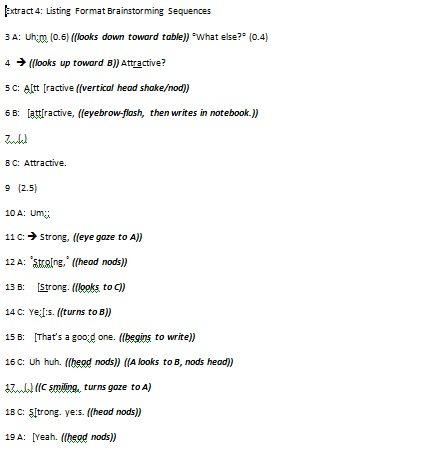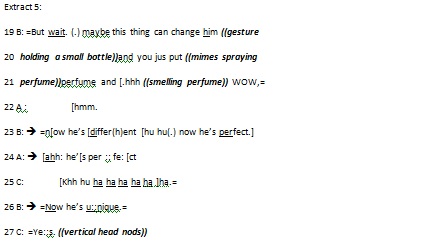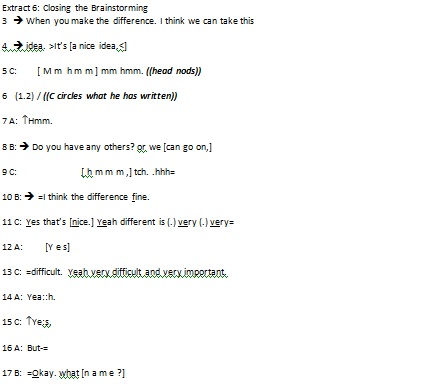BRAINSTORMING AS LISTING ADJECTIVES
Even though the speakers seem to understand what is meant by brainstorming, one member feels it is important to define it as one particular kind of brainstorming: listing. They had already been spontaneously listing adjectives before he suggested brainstorming, so he seems to be using that as a model, but in any event he further suggests, "Let's just list adjectives," and they proceed with a listing format brainstorming activity.

Here are two examples of the listing sequence, in Extracts 4 and 5. Notice the (arrowed) nomination turns, followed by repeats of the nominated word, yes-type ratifications ("yeah," "yes"), and positive assessments ("okay," "that's a good one") (see Goodwin & Goodwin 1992; Pomerantz 1974).

In Extract 5, student B had an idea that he explained by telling a story, a science fiction scenario set in a future where women feel men are like robots, and then the perfume transforms one man into a unique and attractive man.

CLOSING OF BRAINSTORMING―AGREEMENT ON "IDEA"
The brainstorming closes when the group moves to select a choice from the listed ideas, an adjective to stand for the image or concept for their imagined perfume product. This is not yet the perfume's name, but the "idea for the idea." Here is the final agreement sequence:

SUMMARY AND IMPLICATIONS
I have introduced examples of brainstorming as well as examples of the ways the speakers set up and ended a listing-type brainstorming that ended up in the creation of a concept for their perfume: difference. Though the process looks simple, with nominations made by saying a new adjective and responses made with yes-type ratifications and positive assessments, this is a rich activity in which ideas are told through stories at times and repair (Schegloff, Jefferson, & Sacks 1977) and defining words provide rich learning opportunities. This brainstorming involves a special speech exchange system, a listing-type brainstorm, which can be understood as one variation in the broader ecology of listing activities (Jefferson, 1991) and perhaps one of several kinds of brainstorming talk. As part of the description of the many speech exchange systems undertaken in small-group activities in language classrooms, this study provides one more piece and reveals the kinds of interactional resources used by fairly fluent English language learners in this kind of activity.
REFERENCES
Goodwin, C., & Goodwin, M. H. (1992). Assessments and the construction of context. In A. Duranti & C. Goodwin (Eds.), Rethinking context (pp. 147-189). Cambridge, England: CambridgeUniversity Press.
Jefferson, G. (1991). List construction as a task and resource. In G. Psathas (Ed.), Interactional competence (pp. 63-92). New York, NY: Irvington Publishers.
Osborn, A. (1953). Applied imagination: Principles and procedures of creative problem solving. New York, New York: Charles Scribner's Sons.
Pomerantz, A. (1984). Agreeing and disagreeing with assessments: Some features of preferred/dispreferred turn shapes. In M. Atkinson & J. Heritage (Eds.), Structures of social action: Studies in conversation analysis (pp. 57-101). Cambridge: Cambridge University Press.
Sacks, H., Schegloff, E. A., & Jefferson, G. (1974). A simplest systematics for the organization of turn-taking for conversation . Language, 50(4), 696-735.
Schegloff, E. A. (2007). Sequence organization in interaction. Cambridge and New York: CambridgeUniversity Press.
Schegloff, E. A. (1987). Analyzing single episodes of conversation: An exercise in conversation analysis. Social Psychology Quarterly, 50(2), 101-114.
Schegloff, E. A., Jefferson, G., & Sacks, H. (1977). The preference for self-correction in the organization of repair in conversation. Language, 53, 361-382.

